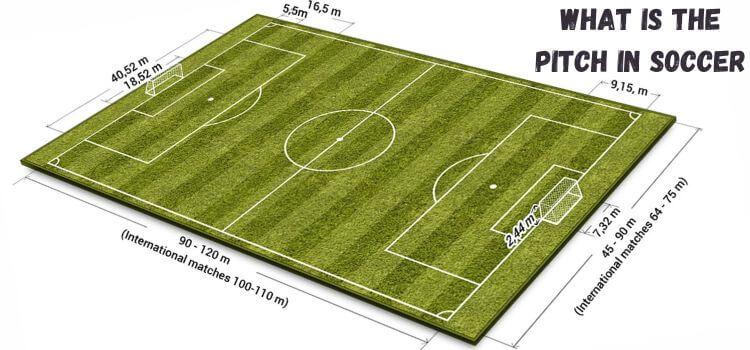As an Amazon Associate, I earn from qualifying purchases
In the vibrant world of soccer, understanding the pitch is fundamental to grasping the essence of the game. But what exactly is the pitch in soccer?
The stage where the beautiful game unfolds is the pitch, the soccer field, or the playing surface. It’s not merely a patch of grass; it’s the battleground where athletes showcase their skills, tactics, and teamwork.
Delving into the intricacies of the pitch illuminates the strategic maneuvers and exhilarating moments that define the sport. So, let’s dive into the soccer pitch’s dimensions, markings, and significance, unraveling its role in the heart-pounding action on match day.

Understanding the Pitch in Soccer
Soccer, often called the world’s most popular sport, is known for its fast-paced action, skillful maneuvers, and passionate fanbase. At the heart of every soccer match lies the playing field, the pitch.
Understanding the dynamics of the soccer pitch is crucial for players, coaches, and fans alike, as it significantly influences the gameplay and strategy teams employ.
Dimensions of a Soccer Pitch
FIFA, the governing body of world soccer, regulates the dimensions of a standard soccer pitch. A typical pitch measures approximately 100-110 meters long and 64-75 meters wide.
However, variations in pitch dimensions are allowed within certain limits, especially in non-professional leagues and smaller venues.
Components of a Soccer Pitch
A soccer pitch has several key components that shape the game’s flow. These include goalposts and nets, the penalty area, the center circle, and the touchlines and goal lines. Each component serves a specific purpose and contributes to the overall dynamics of the match.
Roles of the Pitch in Gameplay
The layout and condition of the pitch play a crucial role in determining the strategy and tactics teams employ—the size and shape of the pitch influence player positioning, passing patterns, and defensive strategies.
Teams often adapt their gameplay based on the specific characteristics of the pitch they are playing on.
Pitch Conditions
The pitch condition can significantly impact a soccer match’s outcome. Weather, pitch maintenance, and playing surface affect the ball’s movement and player performance. Groundskeepers work tirelessly to ensure the pitch is optimal for gameplay, addressing issues such as grass length, soil quality, and drainage.
Pitch Regulations
FIFA establishes regulations governing the construction and maintenance of soccer pitches to ensure fairness and safety for all players.
These regulations cover pitch dimensions, goalpost specifications, and field markings. Local governing bodies may also impose additional guidelines to suit specific playing conditions and environments.
Pitch Etiquette
Respecting the pitch is paramount in soccer, with players and coaches expected to uphold specific standards of behavior.
This includes avoiding unnecessary damage to the pitch, adhering to substitution protocols, and following instructions from referees and officials.
Maintaining pitch etiquette contributes to a positive playing environment and ensures the longevity of the playing surface.
Pitch Innovations
Advancements in pitch technology have revolutionized the game of soccer, with innovations ranging from artificial turf surfaces to hybrid grass systems.
These innovations offer enhanced durability, traction, and playability, providing players with a consistent and reliable surface to showcase their skills.
Additionally, pitch design has incorporated sustainability measures, promoting eco-friendly practices and resource conservation.
Historical Significance of Pitches
The evolution of soccer pitches reflects the growth and development of the sport over time. Soccer pitches have significantly transformed from humble beginnings on makeshift fields to state-of-the-art stadiums with impeccable playing surfaces.
Milestones in pitch design and construction have shaped the way the game is played and experienced by players and fans around the world.
Training on the Pitch
Soccer players utilize the pitch not only for competitive matches but also for training and practice sessions.
Training drills and exercises are tailored to specific gameplay aspects, such as ball control, passing accuracy, and tactical positioning. Coaches leverage the pitch’s features to create realistic scenarios that simulate match conditions and challenges.
Pitch Safety
Ensuring players’ safety is a top priority in soccer pitches. Regular inspections, proper maintenance, and adherence to safety standards help minimize the risk of injuries during matches and training sessions.
Players are also encouraged to take precautions, such as wearing appropriate footwear and warming up properly before engaging in physical activity on the pitch.
Pitch Adaptations
Soccer pitches can be adapted to accommodate players of all ages and abilities. Youth leagues often utilize smaller pitch sizes and modified rules to suit the developmental needs of young players.
Similarly, adaptations are made for players with disabilities, including specialized playing surfaces and equipment to facilitate participation and enjoyment of the game.
Pitch in Professional Soccer
In professional soccer leagues, pitch quality can significantly impact the outcome of matches and the overall spectator experience. Well-maintained pitches provide a conducive environment for players to showcase their skills and execute their strategies effectively.
Additionally, the pitch’s aesthetics contribute to the overall ambiance of the stadium, enhancing the enjoyment of spectators and television viewers alike.
Future Trends in Pitch Design
Looking ahead, the future of soccer pitch design promises to be innovative and dynamic. Advancements in technology, sustainability, and fan engagement are expected to shape the next generation of soccer pitches.
The possibilities are endless, from intelligent stadiums with cutting-edge features to eco-friendly playing surfaces that minimize environmental impact. As the sport continues to evolve, so will the pitches on which it is played.
Conclusion
The soccer pitch is the canvas upon which the beautiful game is played, influencing every aspect of gameplay and strategy. Understanding the pitch’s dimensions, components, and conditions is essential for players, coaches, and fans to appreciate the nuances of soccer.
Whether it’s the thrill of scoring a goal or the excitement of a close-fought match, the pitch remains where dreams are realized and memories are made.
Frequently Asked Questions (FAQs)
Understanding the pitch helps players and coaches adapt their strategies to suit the playing conditions, ultimately improving their performance on the field.
Weather conditions, maintenance practices, and the type of playing surface are some factors that can impact the condition of a soccer pitch.
It is true that FIFA provides guidelines for the dimensions of a soccer pitch, but local regulations and field sizes allow for some variation.
Advancements in pitch technology offer improved durability, playability, and safety for players, contributing to a more enjoyable and competitive soccer experience.
Regular inspections, proper maintenance, and adherence to safety standards are common measures to minimize the risk of injuries on soccer pitches.
Read Our More Articles
- When Does Fall Soccer Season Start? A Comprehensive Guide
- Does Soccer Have an Off Season? Uncovering the Truth
- How Many Games Are in a Soccer Season? Get the Facts Here!
As an Amazon Associate, I earn from qualifying purchases


